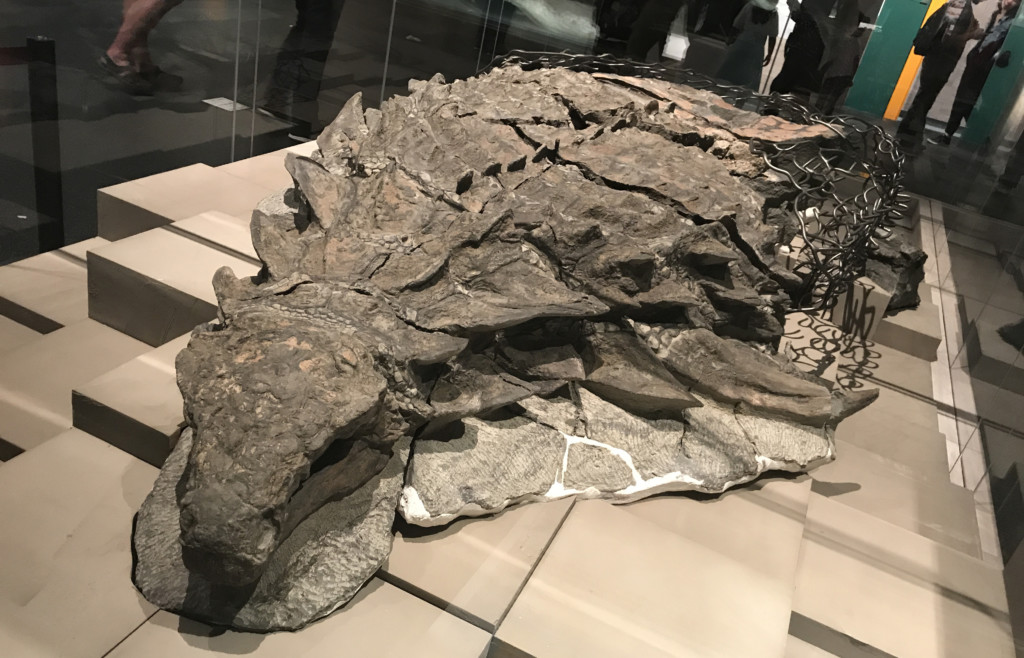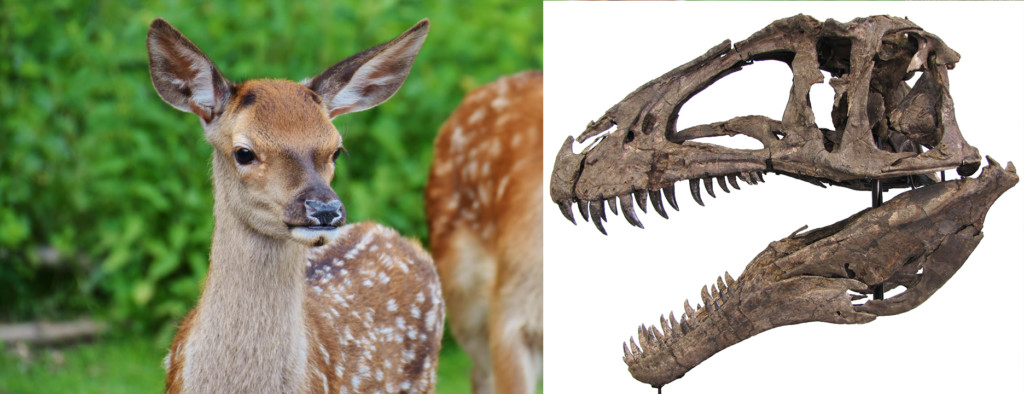
Armored Dinosaur Smashes Evolutionary Assumptions
On March 21, 2011, Shawn Funk, a heavy-equipment operator for the Millennium Mine in Alberta, Canada, discovered something special.
Although unearthing fossils is hardly rare in mining operations, the oddly colored rows of bony plates peeking out from the bedrock suggested that this was something much more than just another petrified stump.

Borealopelta markmitchelli on display at the Royal Tyrrell Museum in Alberta, Canada (Image source).
After six years of painstaking and tedious extraction, the new fossil, Borealopelta markmitchelli, made its public debut at the Royal Tyrrell Museum. The stunning fossil, which more closely resembles a statue than your typical, pile-of-bones fossil, not only represents an entirely new genus of nodosaur (a family of armored dinosaurs, similar to the more famous ankylosaurs), but is also one of the most perfectly-preserved dinosaurs of all time!
While the fossil’s striking appearance was enough to generate significant buzz at the time of its unveiling, no in-depth analysis of the remains had yet been published. That has now changed, and the results are almost as exciting as the initial find itself.
A Dinosaur Autopsy
B. markmitchelli began its journey to fossil stardom during the mid-to-late Inundatory Stage of the Flood. Analysis of the carcass, its mode of preservation, and the lithology of the surrounding rock, suggest that the animal drowned and was washed out to sea, where it bloated, burst, and sank to the bottom of the ocean floor. There, it landed with enough force to create a shallow crater, which would later become filled in with fine, marine sediments, forming a natural sarcophagus that protected its body from further decay.1)
Far from a mere skeleton, the specimen preserves nearly the entire front half of the creature, including its scaly skin and trademark armor plates, called “osteoderms,” still in their life positions (a rarity among armored dinosaurs, as osteoderms usually scatter quickly after death). A closer look reveals even more detail, as many of the osteoderms and body spikes retain patches of the dark, keratinous sheath that would have covered them in life. This material, partly decayed, has created a thin, organic film over certain parts of the body2).
Pigments have also been recovered from the fossil, indicating that the B. markmitchelli would have had reddish-brown scales with a lighter underbelly3). This color pattern, called “countershading,” is a form of camouflage found in many herbivores today. Finding this same pattern on an animal as large as B. markmitchelli suggests that it was actively hunted by even larger, vision-based predators, such as the vicious Acrocanthosaurs (skull pictured below).

Countershading, as seen in the roe deer above, is a form of camouflage in which the animal’s coloring is darker on the top side of the body and lighter on the underside. Seen in many modern herbivores, it is less common among large animals, whose size alone is usually enough to deter would-be attackers. The presence of countershading in an animal as large as B. markmitchelli suggests that it was actively stalked by even larger predators, such as the deadly Acrocanthosaurs (right – Image source).
The Deep Time Dilemma
Once thought to be an impossible dream, pigments have been recovered from a number of fossil species, including Sinosauropteryx4) (a small theropod dinosaur) and several species of ancient bird.
This creates a problem for Darwinian scientists, as, according to secular dating methods, many of these fossils are well over 100 million years old! How is it possible for these biomolecules to have survived for so long? Brian Thomas, a writer for the Institute for Creation Research, describes the problem further:
“Only a decade ago, secular thinkers openly resisted original melanin discoveries in fossils like bird feathers and animal skins on the basis of their expectation that biochemicals like these decay after only thousands of years. While science still has not found a way pigments could last millions of years, melanin fossil finds like this one keep piling up.
Until some new study shows why the laws of chemical decay should not apply to them, intact proteins and original pigments in fossils confront evolutionary time.”5)
The age of the Earth is a hot topic within the origins debate. Those on the side of Darwinism claim that the Earth and its fossils are many millions of years old (billions in the case of the Earth itself), while those on the side of Biblical Creation maintain that the Earth is rather young – a mere 6,000 to 10,000 years old, with its fossils even younger than that.
Those holding to young Earth beliefs are often ridiculed, as radioisotope dating has allegedly proven the rocks to be old, but why are radioisotopes the only molecular evidence ever considered?
Pigments, proteins, and other biomolecules and soft tissues are observationally known to decay rapidly, and while some may be hardier than others, the likelihood of any of them lasting for more than a million years is practically zero. Despite this, more fossils are being discovered with these organic remnants every day.
Given this fact, as well as the repeated failures of radiometric dating when applied to rocks of known age6), one would think it obvious that the traditional, old Earth dates are in need of a serious overhaul.
References
| ↑1, ↑2, ↑3 | Brown, Caleb M., Donald M. Henderson, Jakob Vinther, Ian Fletcher, Ainara Sistiaga, Jorsua Herrera, and Roger E. Summons. “An Exceptionally Preserved Three-Dimensional Armored Dinosaur Reveals Insights into Coloration and Cretaceous Predator-Prey Dynamics.” Current Biology 27, no. 16 (2017). doi:10.1016/j.cub.2017.06.071. |
|---|---|
| ↑4 | Kaplan, Matt. “Fossil feathers reveal dinosaurs’ true colours.” Nature News. January 27, 2010. Accessed September 01, 2017. http://www.nature.com/news/2010/100127/full/news.2010.39.html. |
| ↑5 | Thomas, Brian, M.S. “Spectacular Dinosaur Has Skin, Horn, Pigments.” Spectacular Dinosaur Has Skin, Horn, Pigments | The Institute for Creation Research. August 28, 2017. Accessed September 01, 2017. http://www.icr.org/article/10194/. |
| ↑6 | “More and more wrong dates.” Creation Ministries International | creation.com. Accessed September 01, 2017. https://creation.com/more-and-more-wrong-dates-radio-dating-in-rubble. |
